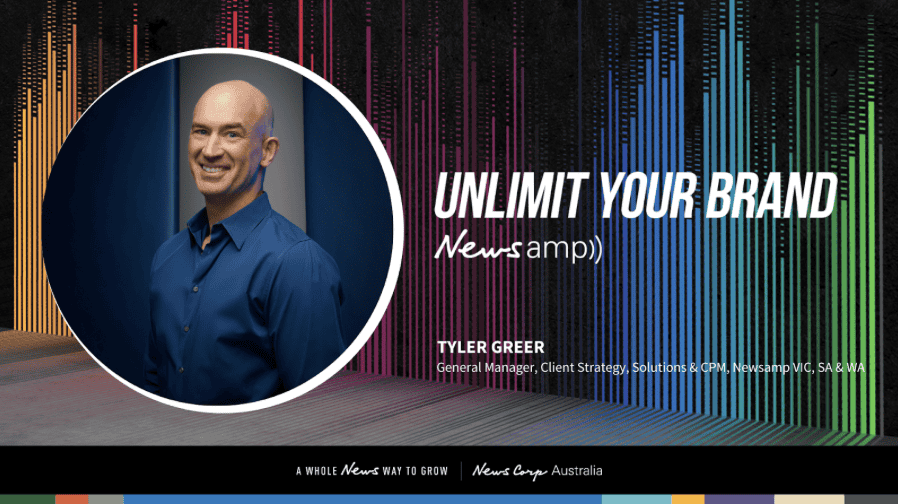By Tyler Greer, general manager of client strategy, solutions and CPM – Newsamp VIC, SA and WA
I used to travel to South Africa annually for work. Nice place, if you’re careful. The plane ride there is long and unusual in its route. Leaving Australia via Sydney, the flight path takes you south, very south, until you hit the air space of Antarctica. From there, you skirt the edge of the frozen continent for about nine hours before veering northward to J’burg.
And if you believe the talk, this middle part of the journey, spent at the bottom of the world, is so isolated, it is completed in the absence of connection to, well, anyone. The plane is off the grid. Trying concentrating on your movie knowing that. Contact is only re-established once the flight gets nearer to Africa.
Whether this is true or not doesn’t stop me from telling it to anyone who will listen. And it puts me in mind of another journey for which we often, as advertisers and marketers, feel we lose contact through the middle – the consumer journey. This has become known, thanks largely to Google, as ‘The Messy Middle’, and it describes the non-linear process through which decisions are made, incorporating consideration, research, evaluation, comparison, and a whole bunch of other stuff both media and non-media related, experienced on the way to purchase. More than anything, it is the moment at which brand marketers and media buyers feel they have the least contact with their audiences.
To complete the plane trip analogy, consumers are ‘on the radar’ early when targeted with awareness building media, disappear from view through the middle part of the journey, only to re-emerge again closer to market once they have indicated (deliberately or otherwise) they are nearing purchase. Data fragmentation from third party cookie shut down is going to make this signal loss even more acute, further robbing planners of a line of sight.
It is unlikely that consumers feel as challenged. It is, after all, the moment in which they have the most control.
And this may be the most misunderstood aspect for marketers. Early exposure to brands is generally unsought – out of home billboards, radio ads, digital display and pre-roll, and all the other solid placements some of us make a living out of thrusting in front of people – and closer to purchase they are retargeted, often relentlessly.
But the middle part belongs to them. Here, they can take their time, choosing what they wish to consume and learn about products. It’s up to them what they watch or listen to, what they read about. Vexingly, the pace at which they do this is also completely up to them.

If we understand that sense of audience control, we can plan accordingly. Brene Brown, though speaking to the creative process rather than the purchase process, says that ‘the middle is messy but it is also where the magic happens’. Indeed, given that this middle of the funnel moment is where preferences are settled on and decisions made, for brands it can be magic. It is a part in which they can exert significant influence.
This apparent messiness means we spend insufficient time planning for it, but the ways in which we can engage and pursue consumers at this point in their pathway are manifold. Video content is the most obvious. We fixate on bite sized content because we recognise, rightly or wrongly, that attention spans will only accept 6” or less. And for some formats, that may be true. But medium and long form content have critical roles to play in providing brand comprehension.
There is something else that is of crucial importance when it comes to content length: almost everything over 30” in length is viewed at the users’ discretion. Meaning, to activate such content, the audience must choose to watch it. And whilst there won’t be as many of those audience members as there are suffering the albeit short interruption of bite sized short videos, the nature of their opted-in viewership makes them a more likely prospect. Where effective targeting falls short, audience control fills in the gaps.
Written content, particularly integrated native, offers another opportunity to move consumers from awareness, through consideration, and into the pointier end of the funnel. Video may dominate our thinking, but people still like to read. They also like to listen, and the intimacy audio offers is another powerful way for brands to hold longer engagement with audience members.
Instinctively, we get it. I have had a ton of conversations with marketers across the years who leap at the chance to produce and distribute content, activate creative experiences and ad units, and find fresh ways to tell their brand stories. Time spent with their brand is, to traditional marketers at least, of inherent value. It is when it comes to measurement that confidence starts to waiver. Attribution in the middle of the journey can be less clear, or at least not as directly and immediately attributable to outcomes as measuring awareness and exposure at the beginning, and acquisition at the end. But as the bridge between the two, it makes it no less important to activate.
At Newsamp, where I work, we spend a lot of time with Kantar, measuring campaigns. And we do so because much of what we do involves creative integration. That means we help brands tell stories through the storytelling of our own published brands. Testing for brand uplift and awareness is not enough; comprehension and affinity matters too.
Critically, a focus on these goals achieve something greater for brands in their overall health. Newsamp-generated campaigns have consistently rewritten the Kantar brand norms for across the past five years and much of it is a focus on middle funnel activity including native, content, and integrated storytelling. In other words, giving audiences the opportunity to spend time with your brand is healthy for it.
Talk of the ‘collapsing’ funnel makes it all feel very out of fashion, but that doesn’t make it wrong.
There is likely little new thinking in this piece about why the middle matters, but we seem to keep talking about it as the third, forgotten child of the Funnel Family. But it is helpful, perhaps, to reframe this not as a point of mess and unhelpful signal loss, but a point at which the audience enters the cockpit and steers the plane in the direction it finds most helpful or appealing.
If we accept this idea, we can better understand the kinds of gateways to content and information they may be seeking out. And we can begin apportioning appropriate value to those who have made time with brand a choice.
The part of the journey that exists between awareness and conversion is not linear but it is no less valuable for it, nor is there less opportunity for brands to exert influence. There have never been more channels or more creative opportunities for brands to offer engagement gateways to audiences and, in doing so, facilitate time spent between the two. Don’t waste it.
